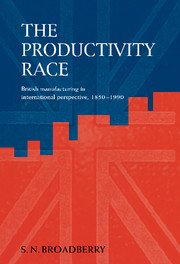Book contents
- Frontmatter
- Contents
- List of figures
- List of tables
- Acknowledgements
- Glossary of terms and company names
- 1 Introduction and overview
- Part 1 measuring comparative productivity performance
- Part 2 explaining compartive productivity performence
- 6 Technology
- 7 Economic geography: markets and natural resources
- 8 Accumulation of physical and human capital
- 9 Competition and adjustment
- Part 3 reassessing the performance of British industry
- Bibliography
- Index
7 - Economic geography: markets and natural resources
Published online by Cambridge University Press: 28 October 2009
- Frontmatter
- Contents
- List of figures
- List of tables
- Acknowledgements
- Glossary of terms and company names
- 1 Introduction and overview
- Part 1 measuring comparative productivity performance
- Part 2 explaining compartive productivity performence
- 6 Technology
- 7 Economic geography: markets and natural resources
- 8 Accumulation of physical and human capital
- 9 Competition and adjustment
- Part 3 reassessing the performance of British industry
- Bibliography
- Index
Summary
Introduction
The historical growth model of chapter 6 has pointed to differences between Europe and America in the areas of resource endowments and demand conditions as important factors explaining technical choice on both sides of the Atlantic. These differences have been highlighted in a number of empirical studies of comparative productivity in manufacturing during the nineteenth and twentieth centuries, including Habakkuk (1962), Ames and Rosenberg (1968), Rostas (1948a), Melman (1956), Frankel (1957) and Wright (1990). Demand factors are considered below, while in the following section the role of resources is examined. As in recent theoretical work on international trade, economic geography is seen to matter (Krugman, 1991).
Demand
Market size and standardisation
An important factor explaining the adoption of machine-intensive production methods in the United States is the nature of demand. Rostas (1948a), Frankel (1957) and more recently Chandler (1990) emphasise the importance of a large homogeneous American home market in permitting economies of scale through the adoption of mass production methods. It should be noted that this is not simply a matter of the size of the home market. For although the population of the United States has been substantially greater than in all individual European countries in the twentieth century, this was not the case for much of the nineteenth century. Data from Maddison (1991) in table 7.1 suggest that the US population level overtook the British level only during the 1850s, and pulled decisively ahead of the German level as late as the 1870s.
- Type
- Chapter
- Information
- The Productivity RaceBritish Manufacturing in International Perspective, 1850–1990, pp. 90 - 103Publisher: Cambridge University PressPrint publication year: 1997



